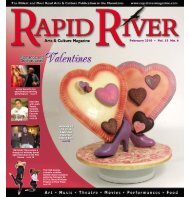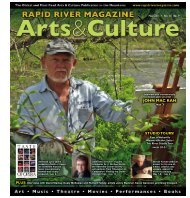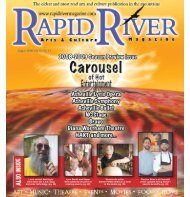FiNE ART - Rapid River Magazine
FiNE ART - Rapid River Magazine
FiNE ART - Rapid River Magazine
You also want an ePaper? Increase the reach of your titles
YUMPU automatically turns print PDFs into web optimized ePapers that Google loves.
R A P I D R I V E R A R T S & C U L T U R E M A G A Z I N E<br />
The Tulip Poplar<br />
The magnificent tulip poplar usually<br />
blooms in May but unless<br />
you can look up at a tree in your<br />
yard or live close by, the only<br />
time you see the blooms are after<br />
storms or when looking out from<br />
somebody’s deck or balcony.<br />
Both Washington and Jefferson grew<br />
this magnificent tree just adding one<br />
more star to its already illustrative biography.<br />
The Tulip Tree is the state tree of<br />
Indiana and Tennessee. Some historians<br />
claim that Daniel Boone built a sixty-foot<br />
pirogue (a dugout boat), from a single<br />
tulip tree trunk to carry his family down<br />
the Ohio <strong>River</strong> from Kentucky out to the<br />
western frontier. It’s rare for a tree that<br />
sends up such fast-growing seedlings to<br />
become with maturity one of the finest<br />
symbols of our natural heritage — although<br />
Thoreau only<br />
mentioned the tree<br />
in one journal entry,<br />
noting its growth in<br />
moist ravines and writing<br />
that: “… its dried<br />
tulip-shaped relic of a<br />
flower, the broad flat<br />
stamens still remaining… a medicinal<br />
odor, somewhat like fever-bush, in the<br />
bark of twigs.”<br />
This tree bears many common names<br />
including yellow-poplar, blue-poplar,<br />
tulip-poplar, tuliptree, and yellow wood<br />
but most gardeners, including Jefferson,<br />
called it the tulip poplar. The scientific<br />
name is Liriodendron tulipifera with<br />
the genus taken from the Greek, leiron,<br />
for lily (referring to the flowers), and<br />
dendron, for tree. The species means<br />
tulip-bearing. Unfortunately for the tree’s<br />
reputation, it’s not a poplar at all but a<br />
member of the magnolia family. There<br />
are only two species in the genus, one in<br />
America and one in China (Liriodendron<br />
chinense) but our species grows taller and<br />
has larger flowers.<br />
Fast-growing and able to live over<br />
300 years, with a trunk approaching five<br />
to ten feet in diameter, the tulip poplar<br />
inhabits eastern North American ranging<br />
from Vermont, west through southern<br />
Ontario and Michigan, south to Louisiana,<br />
and east to northern Florida. Second<br />
only to sycamores in trunk diameter, for<br />
their youthful abundance, they are difficult<br />
to transplant and should be moved<br />
when young saplings and in active growth<br />
taking as much root as possible.<br />
One of the best-known tulip poplars<br />
was the tree that George Washington tied<br />
his horse to when he worshiped at Falls<br />
Church, Virginia before the Revolutionary<br />
war. At that time the tree was at least<br />
300 years old. The historic Davie Poplar<br />
on the University of North Carolina<br />
Thoreau's Garden<br />
campus is another<br />
of the oldest<br />
tulip poplars<br />
in the country.<br />
It was under<br />
this tree that<br />
General Davie<br />
took lunch when<br />
in 1789 he and<br />
his committee<br />
selected Chapel<br />
Hill as the seat of<br />
the University.<br />
This massive tree<br />
has been struck by lightning and survived<br />
several hurricanes, including the damage<br />
caused in 1996 by Hurricane Fran. Davie<br />
Poplar Jr., grown from a cutting, and<br />
Davie Poplar III, grown from the eldest<br />
tree’s seed, are planted nearby.<br />
Let’s<br />
not forget<br />
the tulip<br />
poplar<br />
planted in<br />
1785 by<br />
Washington<br />
at Mt.<br />
Vernon, since designated Mount Vernon’s<br />
official Bicentennial Tree. Because the tulip<br />
poplar flowers only bloom at tree-top<br />
— and most bees only fly fifty feet or so<br />
in the air — the National Arboretum has<br />
been manually pollinating these flowers<br />
since 1989 using a lift bucket and Q-tips.<br />
Seedlings of this tree were sent to replace<br />
tulip poplars destroyed in the 1999 hurricane<br />
at the palace at Versailles.<br />
And the flowers! They are showy and<br />
handsome with orange tints brushed over<br />
greenish-yellow corollas, marked to attract<br />
bees. One of John James Audubon’s<br />
great bird lithographs portrays the upper<br />
reaches of a blooming tulip poplar with<br />
a flock of Baltimore oriels flying about a<br />
nest, surrounded by attractive leaves and<br />
two glorious flowers.<br />
The blossoms look like magnolias<br />
until the central spike splits open to reveal<br />
the seeds. Upon maturity most magnolia<br />
seedpods open up the back, but tulip<br />
poplar fruits are dry and don’t open. A<br />
flat wing rises above the seed box and<br />
the contraption flies away on the autumn<br />
breezes.<br />
The bark of these trees is gray and<br />
closely ridged. The leaves are truncate<br />
with four lobes and shallowly notched<br />
at the end, a smooth, dark green above<br />
and light green below, turning a beautiful<br />
yellow in the fall. In silhouette, the leaves<br />
suggest a tulip. The trunks of old trees are<br />
often branchless for quite a distance up.<br />
The specimen in my front yard shoots<br />
straight up with the first lateral branch<br />
about twenty feet in the air.<br />
Some historians claim that<br />
Daniel Boone built a sixty-foot<br />
boat from a single tulip tree.<br />
Flower from the tulip poplar, or<br />
Liriodendron tulipifera.<br />
by Peter Loewer<br />
The wood<br />
has long held<br />
high prominence<br />
for construction<br />
lumber and for<br />
plywood. The grain<br />
is straight, there’s<br />
little shrinkage,<br />
and it has excellent<br />
gluing qualities. In<br />
Jefferson’s time it<br />
was used for carriage<br />
bodies and<br />
shingles while today<br />
it’s used for cabinets, furniture, and pulp.<br />
In addition to humanity, deer browse<br />
on the seedlings, hummingbirds visit<br />
the flowers, and according to the honey<br />
industry, the flowers from twenty-yearold<br />
tree produce enough nectar to make<br />
four pounds of honey. In addition birds<br />
and small animals feed on the winged<br />
fruits, called samaras (and it should be<br />
noted that few of those seeds are fertile).<br />
It’s a favorite nesting tree for many birds<br />
and the flowers are a marvelous nectar<br />
source for humming birds. Tiger swallowtail<br />
butterflies use the leaves. Even<br />
bears occasionally spend winter sleeping<br />
in the huge hollows that often develop in<br />
old trees.<br />
In the 1800s a heart stimulant was<br />
extracted from the inner bark of the roots<br />
and a rheumatism tonic came from the<br />
stem bark — so Thoreau was correct in<br />
his observations.<br />
The tulip poplar is a noble lawn<br />
and shade tree and probably has a better<br />
reputation in Europe than here. As others<br />
have written: “There is no season when<br />
the tree is not full of interest and beauty,<br />
no matter what its age.”<br />
Peter Loewer examines some<br />
Lenten roses.<br />
Peter Loewer is a well-known writer<br />
and botanical artist who has written and<br />
illustrated over twenty-five books on natural<br />
history over the past thirty years.<br />
Meet the New Kid<br />
on the Block<br />
Come visit the<br />
new kid at the<br />
Western North<br />
Carolina Nature<br />
Center,<br />
75 Gashes<br />
Creek Road in<br />
East Asheville.<br />
Cocoa, the<br />
Center’s Nigerian<br />
Dwarf<br />
goat, gave birth for the first time,<br />
Thursday, May 15, to a very cute little<br />
brown kid. Mom and kid are both doing<br />
well, but please don’t touch until<br />
this kid grows older!<br />
Cocoa has resided at the Nature<br />
Center since 2005. The father, Walker,<br />
also of the same breed, has returned to<br />
Reid Hill Farm after a brief appearance<br />
at the Nature Center this past winter.<br />
For more information on this<br />
new kid, please call Henry Bulluck,<br />
Animal Curator, WNC Nature Center,<br />
at (828) 298-5600 ext. 311.<br />
Vol. 11, No. 10 — <strong>Rapid</strong> <strong>River</strong> ArtS & CULTURE <strong>Magazine</strong> — June 2008 15
















